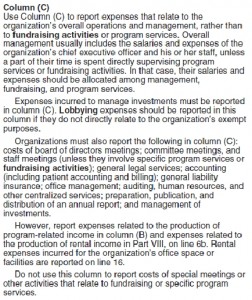Two questions recently got me thinking about administrative and overhead expenses. Below are the questions and the answers I sent:
Question #1: Should a depreciation expense be included in the calculation when looking at the percentage of administration expenses to total operating expenses with a nonprofit?
Answer: It is a good idea to allocate and include depreciation expense in program(s), admin and fundraising. This helps show the cost of doing the work, as at some point equipment will have to be replaced and it is good to know which program is “using” it the most. If your organization does an audit it will show depreciation as a part of your total expenses and allocate it across all your functional areas.
Question #2: We have two independent contractors doing work for our nonprofit. Is the money paid to these people “administrative costs” straight across, or can we separate it out by program? Doesn’t this all come under administrative costs?
Answer: How you code the transactions will depend on the type of work you paid for. If the consultants worked on administrative tasks, their fees would be an administrative cost, if they worked in program areas it would be program costs. Just because the expense is for an independent contractor does not mean it is automatically an administrative cost.
I’ve linked to this topic in my Q&A section and below is what the IRS says about administrative costs in the updated Form 990 instructions on page 33:
A nonprofit’s expenses are classified by what they were used for within the three broad categories / functional areas of administration, program and fundraising. Program costs are considered direct expenses, expenses that have a direct effect on fulfilling the mission of the nonprofit organization. Administrative costs are indirect expenses, they affect the mission of the organization indirectly. The organization can’t get by without those expenses but, according to the IRS and others, they have no direct effect on the mission.
This point, of course, can be argued and I think it is where much of the confusion resides when talking about classifying nonprofit expenses. But this is the world we operate in and those are the rules, so it is best to make sure we understand the rules so we can present our numbers in the most honest fashion to show what it costs to do the work we do.
Another nice breakdown of what administrative / overhead costs are comes from this post from the Nonprofits Assistance Fund. It links to this pdf of overhead cost definitions which is very handy. That post also brings up the specter nonprofits face of spending too much on overhead expenses and the focus on the financial ratio of administrative expenses to program expenses. While that may be a useful figure, I think we need to always keep in mind just what expenses are admin and what are program so we know just what is being measured. Then we need to make sure that as a sector we are all labeling our expenses the same way.
And while we are looking at those ratios we need to look at the nonprofit’s ability to deliver its mission. One financial ratio used in isolation is no true measure of any organization. Only by looking at both the numbers and the program outcomes can we judge whether an organization is effective or not.



